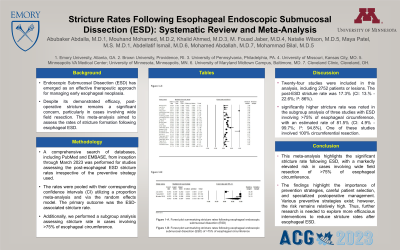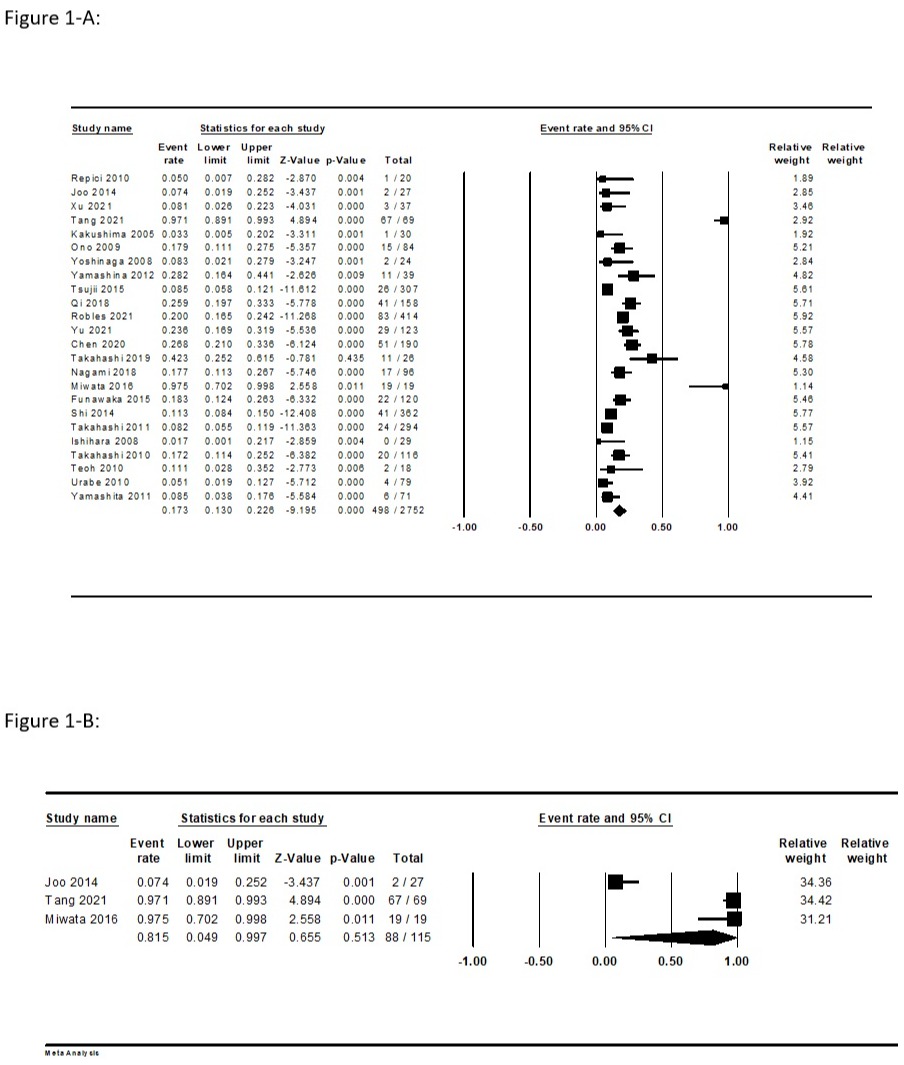Monday Poster Session
Category: Interventional Endoscopy
P2275 - Stricture Rates Following Esophageal Endoscopic Submucosal Dissection: Systematic Review and Meta-Analysis
Monday, October 23, 2023
10:30 AM - 4:15 PM PT
Location: Exhibit Hall

Has Audio

Abubaker Abdalla, MD
Emory University
Atlanta, GA
Presenting Author(s)
Award: Presidential Poster Award
Abubaker Abdalla, MD1, Mouhand FH. Mohamed, MD2, Khalid Ahmed, MD3, Fouad Jaber, MD4, Natalie Wilson, MD5, Maya Patel, MS, MD6, Abdellatif Ismail, MBBS, MD7, Mohamed Abdallah, MD5, Mohammad Bilal, MD8
1Emory University, Atlanta, GA; 2Brown University, Providence, RI; 3The Wright Center for GME, Scranton, PA; 4University of Missouri-Kansas City, Kansas City, MO; 5University of Minnesota, Minneapolis, MN; 6Emory University School of Medicine, Atlanta, GA; 7University of Maryland Medical Center Midtown Campus, Baltimore, MD; 8Minneapolis VA Medical Center, Minneapolis, MN
Introduction: Endoscopic Submucosal Dissection (ESD) has emerged as an effective therapeutic approach for managing early esophageal neoplasia. Despite its demonstrated efficacy, post-operative stricture remains a significant concern, particularly in cases involving wide field resection. This meta-analysis aimed to assess the rates of stricture formation following esophageal ESD.
Methods: A comprehensive search of databases, including PubMed and EMBASE, from inception through March 2023 was performed for studies assessing the post-esophageal ESD stricture rates irrespective of the preventive strategy used. The rates were pooled with their corresponding confidence intervals (CI) utilizing a proportion meta-analysis and via the random effects model. The primary outcome was the ESD-associated stricture rate. Additionally, we performed a subgroup analysis assessing stricture rate in cases involving >75% of esophageal circumference. The heterogeneity across studies was examined using the I-squared (I²) statistic.
Results: Twenty-four studies were included in this analysis, including 2752 patients or lesions. The post-ESD stricture rate was 17.3% (CI: 13.% - 22.6%; I²: 86%). A significantly higher stricture rate was noted in the subgroup analysis of three studies with ESD involving >75% of esophageal circumference, with an estimated rate of 81.5% (CI: 4.9% - 99.7%; I²: 94.8%). Two of these studies involved ESD of >75% of esophageal circumference, and one study involved 100% circumferential resection.
Discussion: This meta-analysis highlights the significant stricture rate following ESD, with a markedly elevated risk in cases involving wide field resection of >75% of esophageal circumference. The findings highlight the importance of prevention strategies, careful patient selection, and specialized postoperative management. Various preventive strategies exist, however, the risk remains relatively high. Thus, further research is needed to explore more efficacious interventions to reduce stricture rates after esophageal ESD.

Disclosures:
Abubaker Abdalla, MD1, Mouhand FH. Mohamed, MD2, Khalid Ahmed, MD3, Fouad Jaber, MD4, Natalie Wilson, MD5, Maya Patel, MS, MD6, Abdellatif Ismail, MBBS, MD7, Mohamed Abdallah, MD5, Mohammad Bilal, MD8. P2275 - Stricture Rates Following Esophageal Endoscopic Submucosal Dissection: Systematic Review and Meta-Analysis, ACG 2023 Annual Scientific Meeting Abstracts. Vancouver, BC, Canada: American College of Gastroenterology.
Abubaker Abdalla, MD1, Mouhand FH. Mohamed, MD2, Khalid Ahmed, MD3, Fouad Jaber, MD4, Natalie Wilson, MD5, Maya Patel, MS, MD6, Abdellatif Ismail, MBBS, MD7, Mohamed Abdallah, MD5, Mohammad Bilal, MD8
1Emory University, Atlanta, GA; 2Brown University, Providence, RI; 3The Wright Center for GME, Scranton, PA; 4University of Missouri-Kansas City, Kansas City, MO; 5University of Minnesota, Minneapolis, MN; 6Emory University School of Medicine, Atlanta, GA; 7University of Maryland Medical Center Midtown Campus, Baltimore, MD; 8Minneapolis VA Medical Center, Minneapolis, MN
Introduction: Endoscopic Submucosal Dissection (ESD) has emerged as an effective therapeutic approach for managing early esophageal neoplasia. Despite its demonstrated efficacy, post-operative stricture remains a significant concern, particularly in cases involving wide field resection. This meta-analysis aimed to assess the rates of stricture formation following esophageal ESD.
Methods: A comprehensive search of databases, including PubMed and EMBASE, from inception through March 2023 was performed for studies assessing the post-esophageal ESD stricture rates irrespective of the preventive strategy used. The rates were pooled with their corresponding confidence intervals (CI) utilizing a proportion meta-analysis and via the random effects model. The primary outcome was the ESD-associated stricture rate. Additionally, we performed a subgroup analysis assessing stricture rate in cases involving >75% of esophageal circumference. The heterogeneity across studies was examined using the I-squared (I²) statistic.
Results: Twenty-four studies were included in this analysis, including 2752 patients or lesions. The post-ESD stricture rate was 17.3% (CI: 13.% - 22.6%; I²: 86%). A significantly higher stricture rate was noted in the subgroup analysis of three studies with ESD involving >75% of esophageal circumference, with an estimated rate of 81.5% (CI: 4.9% - 99.7%; I²: 94.8%). Two of these studies involved ESD of >75% of esophageal circumference, and one study involved 100% circumferential resection.
Discussion: This meta-analysis highlights the significant stricture rate following ESD, with a markedly elevated risk in cases involving wide field resection of >75% of esophageal circumference. The findings highlight the importance of prevention strategies, careful patient selection, and specialized postoperative management. Various preventive strategies exist, however, the risk remains relatively high. Thus, further research is needed to explore more efficacious interventions to reduce stricture rates after esophageal ESD.

Figure: Figure 1-A: Forest plot summarizing stricture rates following esophageal endoscopic submucosal dissection (ESD)
Figure 1-B: Forest plot summarizing stricture rates following esophageal endoscopic submucosal dissection (ESD) of >75% of esophageal circumference
Figure 1-B: Forest plot summarizing stricture rates following esophageal endoscopic submucosal dissection (ESD) of >75% of esophageal circumference
Disclosures:
Abubaker Abdalla indicated no relevant financial relationships.
Mouhand Mohamed indicated no relevant financial relationships.
Khalid Ahmed indicated no relevant financial relationships.
Fouad Jaber indicated no relevant financial relationships.
Natalie Wilson indicated no relevant financial relationships.
Maya Patel indicated no relevant financial relationships.
Abdellatif Ismail indicated no relevant financial relationships.
Mohamed Abdallah indicated no relevant financial relationships.
Mohammad Bilal: Boston Scientific – Consultant.
Abubaker Abdalla, MD1, Mouhand FH. Mohamed, MD2, Khalid Ahmed, MD3, Fouad Jaber, MD4, Natalie Wilson, MD5, Maya Patel, MS, MD6, Abdellatif Ismail, MBBS, MD7, Mohamed Abdallah, MD5, Mohammad Bilal, MD8. P2275 - Stricture Rates Following Esophageal Endoscopic Submucosal Dissection: Systematic Review and Meta-Analysis, ACG 2023 Annual Scientific Meeting Abstracts. Vancouver, BC, Canada: American College of Gastroenterology.

